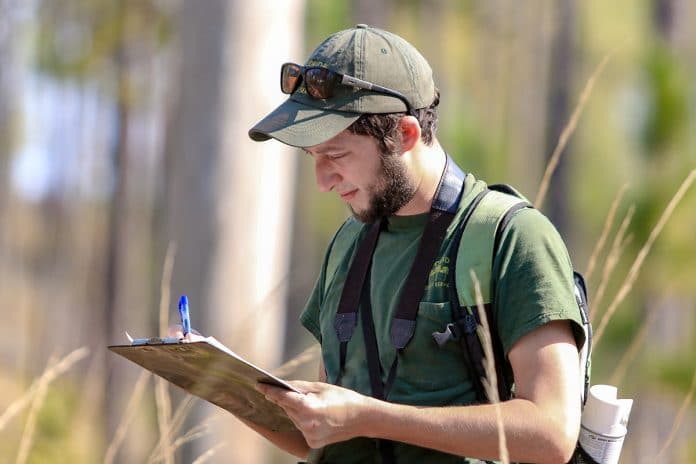Article and Photography by Alice Mary Herden
The Withlacoochee Forest is more than just a forest, it’s filled with nature’s most beautiful timber, Longleaf Pine.
Longleaf Pine is Florida’s native pine tree and is highly sought for lumber. It is also home to the red-cockaded woodpecker.
Before the 20th century the red-cockaded woodpecker was abundant throughout Florida. With the expansion of the turpentine and logging industry, a significant amount of longleaf pine was clear cut placing these birds on the edge of extinction.
It was on October 13, 1970 that the United States Fish and Wildlife Service listed the red-cockaded woodpecker as an endangered species and in Florida as threatened.
“There are only 650 species of birds in North America, and about six have gone extinct. We already lost one woodpecker, the ivory-billed woodpecker,” said Vince Morris, Resource Administrator for the Florida Forest Service. “It’s sad for us to allow one to be lost.”
Just like the red-cockaded woodpecker, the ivory-billed woodpecker required a specific habitat, up to 2000 acres of pristine swamp. The overharvesting of cedar trees may have resulted in their extinction.
If you can travel back before the 1900s, before logging ever touched Hernando County or even Florida for that matter, many species that required specific ecosystems thrived, just like the red-cockaded woodpecker. The red-cockaded woodpecker needs one tree, the longleaf pine, aged 80 years and open sandhill communities.
In the late 1970s, replanting longleaf pine seedlings began to heal the scars left from logging, but there is still much-needed work to bring these woodpeckers back to a thriving population.
Ryan Grumbly, 28, Ecology Forester, has been with Florida Forest Service for five years. He monitors the over 300 red-cockaded woodpeckers (RCWs) within the Croom and Citrus tracts of the Withlacoochee State Forest (approximately 100 RCWs in Croom and 250 in Citrus). His job is to know everything about this species and their environment. Tasks include collecting data on conditions of nesting cavities or breeding, installing and maintaining artificial cavity nests, monitoring nesting behavior and banding eight-day-old chicks. These activities give wildlife biologists and researchers a better understanding of the species.
Months of research and data collections help provide valuable information in order to implement strategies to improve their chances of survival.
Ryan explained that it takes years for a woodpecker to excavate a cavity nest. Once the woodpecker begins excavating its potential nesting cavity, it begins to peck away the layers of bark. As the bird reaches the soft inner wood, the longleaf pine will start to seep resin (sap). The woodpecker will have to wait until that resin dries to continue. This process may take 1-6 years to complete. (The older pines favored by the red-cockaded woodpecker often suffer from a fungus called red heart disease which attacks the center of the trunk, causing the inner wood, the heartwood, to become soft.)
On occasion, the Florida Forest Service will install artificial cavities surrounding active or suitable clusters. A cluster is a group of cavity trees associated with one group of red cockaded woodpeckers. It includes a 200’ buffer around the aggregation of trees. The goal set by Florida Forest Service is to manage 48 clusters in Croom and 120 in Citrus.
The artificial cavities surrounding the clusters allow the red-cockaded woodpecker to spend more time on foraging and breeding rather than excavating.
Once a year Ryan conducts a tree survey. This survey determines if cavity trees are currently active, suitable or no longer being used. If you have ever noticed the white bands on certain pine trees, those are longleaf pines that are either suitable for or occupied by red-cockaded woodpeckers.
“It helps keep track of where you are most likely to find the bird,” Grumbly said. Monitoring clusters in areas of Croom and Citrus is an important part of his job. These surveys determine if the red-cockaded woodpeckers are thriving. They also assess quality of life.
Spring is the prominent time for breeding and presents the best opportunity for Ryan to witness the fruits of his labor.
Ryan documents which pairs have mated and how many eggs the female laid. Once the eggs have hatched successfully, these chicks over a week old are banded. Banding helps track the woodpeckers’ location, development, and genetic line.
There are times when some red-cockaded woodpeckers outside the Withlacoochee State Forest are transferred to or from Citrus or Croom, as this will decrease their chance of inbreeding which facilitates a healthy population.
With the help of those like Ecology Forester Ryan Grumbly, the long term survival of this species is looking better every year.
“The thing I love most about my job is the variety of things I get to learn about,” Grumbly said. “Today, I’m surveying trees, so that later I can find a nest. Then we can deter predators while the eggs hatch. After that we can band the hatchlings, and monitor them as they become adults and hopefully parents themselves.”

